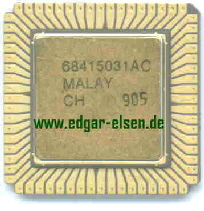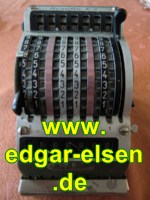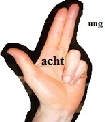|
NEC Corp. v. Intel Corp.
United States District Court
10 U.S.P.Q.2d 1177 (N.D. Cal. 1989)
Gray, D.J.
[NEC sought a declaration that lntel's copyrights on the microcodes in Intel's 8086 and 8088 microprocessor chips were invalid and/or not infringed by the microcode of NEC's V20 chip. Intel counterclaimed for infringement of its copyrights on those microcodes. This portion of the court's opinion is directed to whether microcode is protectable under the copyright laws.]
A microcode consists of a series of instructions [stored in a ROM section of a microprocessor chip] that tell a microprocessor which of its thousands of transistors to actuate in order to perform the tasks directed by the microinstruction set. As such, it comes squarely within the definition of a “computer program,” which Congress added to the Copyright Act in 1980, namely, “a set of statements or instructions to be used directly or indirectly in a computer in order to bring about a certain result.”
A computer program, even though articulated in object code, is afforded copyright protection as a “literary work” under § 101, which includes works “expressed in words, numbers, or other verbal or numerical symbols or indicia, regardless of the nature of the material objects...in which they are embodied.” For a particular literary work to be copyrightable, two requirements must be satisfied: the work must be “fixed in any tangible medium of expression,” and it must be “original”. See 17 U.S.C. § 102(a). It is undisputed that Intel's microcode is fixed in a tangible medium of expression. However, NEC challenges the originality of Intel's microcode, and urges two other bases for denying copyright protection. Originality
NEC contends that many of Intel's microsequences are not copyrightable because they consist only of a few obvious steps and thus lack the originality required for copyright protection. NEC refers to Mr. Nimmer's comment that “illustrative of the requirement of minimal creativity are those cases which deny copyright protection to fragmentary words or phrases, non-creative variations of musical compositions and to forms of expression dictated solely by functional considerations.” An example of such type of case is Alberto-Culver Co. v. Andrea Dumon, Inc., 466 F.2d 705, 711 (7th Cir. 1972), in which the court held that the phrase “most personal sort of deodorant” was not entitled to copyright protection. NEC seeks to have such a ruling applied to several of the microsequences in the Intel microcode that are very short and involve only a few steps.
It well may be that, considered alone, several of the microsequences in Intel's microcode consist of “forms of expression directed solely by functional considerations” lacking even “minimal creativity.” But these examples are only small segments of the copyrighted microcode. As Intel points out, any copyrighted work, be it a poem, novel or computer program, can be chopped into parts that could be said to have very few creative steps.
However, for purposes of copyrightability, “Originality means only that the work owes its origin to the author, i.e., is independently created, and not copied from other works, and that the work contains a modicum of originality, i.e., “exceeds that required for a fragmentary work or short phrase.” The Intel microcode fully meets this test. There is no evidence that Intel's microcode was other than an independent effort and, overall, Intel's microcode exceeds the required modicum of originality.
Microcode As Part of the Computer
As stated above, the Copyright Act defines a computer program as “a set of statements or instructions to be used in a computer.” NEC contends that Intel's microcode is a defining element of the computer itself. According to NEC, Intel's microcode does not come within the definition of a computer program because it cannot be used in a computer and also be a defining part of the computer.
But, as stated at the outset, Intel's microcode is within the statutory definition of a “computer program,” and NEC's semi-semantical argument runs counter to the authority cited by Intel: “There is nothing in any of the statutory terms which suggest a different result [concerning copyrightability] for different types of computer programs based upon the function they serve within the machine.” Apple Computer, Inc. v. Franklin Computer Corp.
Idea v. Expression
It is an axiom of copyright law that only the expression of an idea is copyrightable, not the idea, itself. This doctrine was announced in Baker v. Selden, and a substantial portion has been codified in 17 U.S.C. § 102(b). Stemming from Baker v. Selden is the related doctrine of “merger.” When the “idea” and its “expression” are inseparable, copying the “expression” will not be barred, since protecting the “expression” would confer a monopoly of the “idea” upon the copyright owner free of the conditions and limitations posed by the patent law.
It seems to me that, as a matter of practicality, the issue of a limited number of ways to express an idea is relevant to infringement, but should not be the basis for denying the initial copyright. The Register of Copyrights will not know about the presence or absence of constraints that limit ways to express an idea. The burden of showing such constraints should be left to the alleged infringer. Accordingly, in the absence of Ninth Circuit authority to the contrary, it is concluded that the relationship between “idea” and “expression” will not be considered on the issue of copyrightability, but will be deferred to the discussion of infringement.
It is the view of this court that NEC's above mentioned objections to the copyrightability of Intel's microcode are not persuasive. On the contrary, the statutory references discussed at the outset of this section on copyrightability, and particularly the specific definitions of “computer program” that Congress enacted in 1980, “reflect Congress’ receptivity to new technology and its desire to encourage, through the copyright laws, continued imagination and creativity in computer programming.” Apple Computer, Inc. v. Franklin Computer Corp. In light of the foregoing, it is concluded that Intel's microcode was a proper subject for copyright protection and that the copyright registrations contained thereon were initially valid.
Notes
1. Microprocessor chips are capable of executing a set of so-called “macroinstructions,” which in the aggregate comprise an “instruction set.” A chip macroinstruction is an assembly language expression such as MOV (a,b), which might mean “Move the contents of Register A to Register B. See IEEE Standard Dictionary of Electrical and Electronic Terms 513 (3d ed. 1984).
A chip's instruction set is the repertory of instructions that a microprocessor chip can execute. More generally, the IEEE Standard Dictionary of Electrical and Electronic Terms 445 (3d ed. 1984) defines “instruction set” as “[t]he set of instructions of a computer, of a programming language, or of the programming languages in a programming system.”
An instruction set implicitly defines vocabulary, syntax, and meaning for the instructions that it comprises. Related documentation explicitly defines such vocabulary, syntax, and meaning. The instruction set for the 8086 microprocessor defines the 8086 assembly language. For a more complete technical discussion, see D. Siewiorek, C. Bell & A. Newell, Computer Structures 13-14 (1982).
2. Different microprocessor chips, such as the Intel 8086 and Motorola 6800, have different instruction sets. A company wishing to compete by selling a fungible substitute for another company's microprocessor chip must design its own microprocessor chip to carry out the same instruction set as the other company's chip.
3. Microinstructions are steps which carry out a macroinstruction. The move instruction, for example, may be executed within the processing unit of a microprocessor by from five to ten steps (microinstructions). The machine language and assembly code associated with microinstructions is known as microcode. (The term microcode has a more general meaning, as well, and microcode was first devised many years ago for use in mainframe computers.)
Copyright in Layouts of
 Semiconductor Chips Semiconductor Chips
The layout of a semiconductor chip product (integrated circuit chip) may be analogized to the floorplan of a house. Different portions of the chip serve different functions, as kitchens, bedrooms, and garages do in houses. Functional requirements dictate some parts of the layout — for example, the garage must be placed adjacent to the driveway and the driveway must lead to the street.
Conventional chip manufacturing technology involves a process known as photolithography, in which chip layout patterns are engraved or otherwise manufactured on a silicon (or other semiconductor) wafer. The patterns are imposed, layer by layer, for many chips at a time, side by side, as many stamps are printed at a time on a postage sheet. Photolithography is performed with photomasks, which resemble stencils or printing plates on which the chip layout is fixed.
Part of the design process
 involves encoding the “floorplans” or masks into numerical form and storing the information on database tapes (also referred to as pattern-generation tapes). In effect, a database tape stores the X-Y coordinates of every relevant point in the pattern depicted on a photomask. The technology for this process would permit the encoding of any pictorial information as well. Thus, the Mona Lisa could, in principle, be represented in numerical form in a database tape. Indeed, a digital videotape is similar in principle to such a database tape. involves encoding the “floorplans” or masks into numerical form and storing the information on database tapes (also referred to as pattern-generation tapes). In effect, a database tape stores the X-Y coordinates of every relevant point in the pattern depicted on a photomask. The technology for this process would permit the encoding of any pictorial information as well. Thus, the Mona Lisa could, in principle, be represented in numerical form in a database tape. Indeed, a digital videotape is similar in principle to such a database tape.
These facts about chip manufacture, together with widespread semiconductor industry concern about “chip piracy,” led to efforts in the late 1970s and early 1980s to utilize copyright law as a means of protecting proprietary rights in chip layouts. One approach was to assert pictorial-work copyrights in the photomasks for chips and in the layouts themselves. A second approach was to assert literary-work copyrights in the numerical data compiled in the database tapes. The difficulties with each approach were manifold.
In 1984, Congress responded to the industry's concern over chip piracy, and to a general consensus that approaches to chip protection based on existing copyright law were doomed to failure, by enacting the Semiconductor Chip Protection Act of 1984 (SCPA), 17 U.S.C. §§ 901-914. The legislative history of the SCPA expressly rules out duplicative-copyright law protection for chip layouts. The Senate and House floor statements said (130 Cong. Rec. S12919 and E4433):
[A]s to these chips [manufactured after July 1, 1983], the Act will replace copyright protection. Similarly, the privileges created by this Act, such as the reverse engineering right, may not be restricted by reference to the narrower privileges that obtain under copyright, such as fair use.
The legislative history of this bill includes repeated assurances that mask work protection in no way erodes copyright protection for subject matter such as computer programs or data bases, even if that subject matter is embodied in a semiconductor chip. The converse is also true; assertions of copyright in mask works masquerading as copyright subject matter should not be permitted to detract from the integrity and exclusivity of the protection scheme created by this Act.
|









